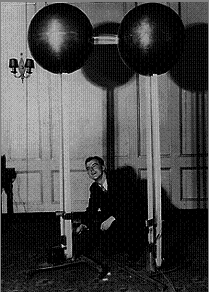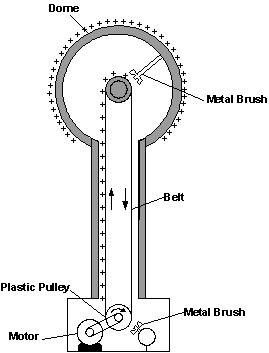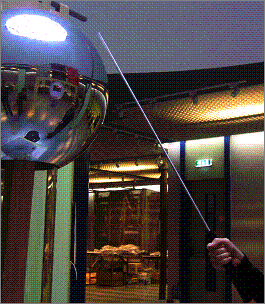Van de Graaff generator
A Van de Graaff Generator is a machine which uses a moving belt to accumulate very high Electrostatic Voltages on a hollow Metal Sphere.
Robert Van de Graaff (1901-1967) was an American physicist and instrument maker. He built the first of these generators about 1930 to accelerate Atomic Particles, Figure 1.
 Figure 1: Robert J. Van de Graaff and an early Van de Graaff Generator
Figure 1: Robert J. Van de Graaff and an early Van de Graaff Generator
Inside the Van de Graaff Generator, the Moving Belt is wound on a Plastic Pulley, Figure 2. When the Motor drives the Pulley, the Belt rubs the Plastic Pulley and gives it Negative Charges. As the Motor continues driving the Pulley, the Negative Charges in the Pulley accumulate and they induce Positive Charges in the sharply pointed Metal Brush. The Electric Field between the Pulley and the Brush increases, so the air around the Brush becomes Ionized. The Positive Charges of the air molecules are repelled from the Brush and attach on the surface of the Belt. Those Positive Charges are then carried up into the hollow Metal Sphere, which is called Dome, and transferred to the Dome via air Ionization and a sharply pointed Metal Brush. This leaves a large amount of Positive Charges on the surface of the Dome and the potential of the Dome rises.
 Figure 2: The Basic Structure of Van de Graaff Generator
Figure 2: The Basic Structure of Van de Graaff Generator
When a Metal Wand is put close to the Metal Sphere, if the Voltage difference between the Metal Wand and the Metal Sphere reach about 30,000 Volts per centimeter of dry air, Current from the Metal Sphere flows to the Metal Wand through the dry air and the sparks can be seen, Figure 3.
 Figure 3: A Metal Wand is put close to the Metal Sphere
Figure 3: A Metal Wand is put close to the Metal Sphere
When people try to touch the Metal Sphere with their hands. their hair will stand out, Figure 4. It is because every single hair is charged with the same charge and they repel each other.
 Figure 4
Figure 4
About CMM
Contact US
Others
Other Websites
Number of Visitors:
Last Modified Date: 10/3/2025